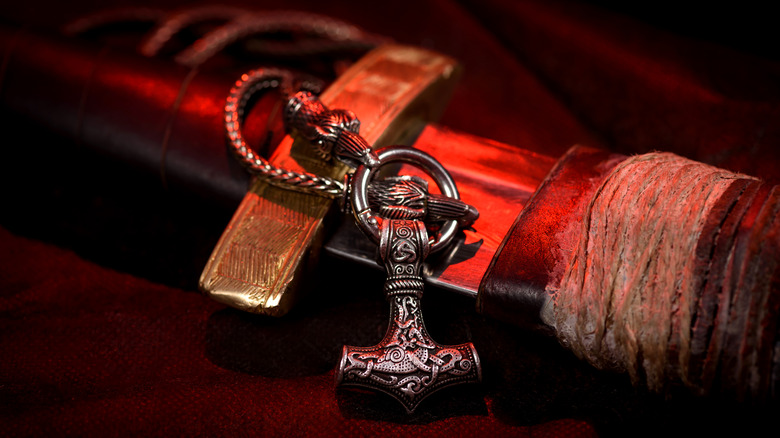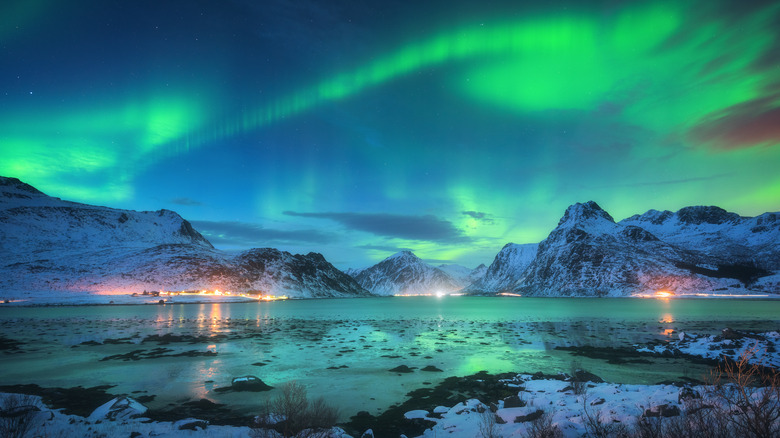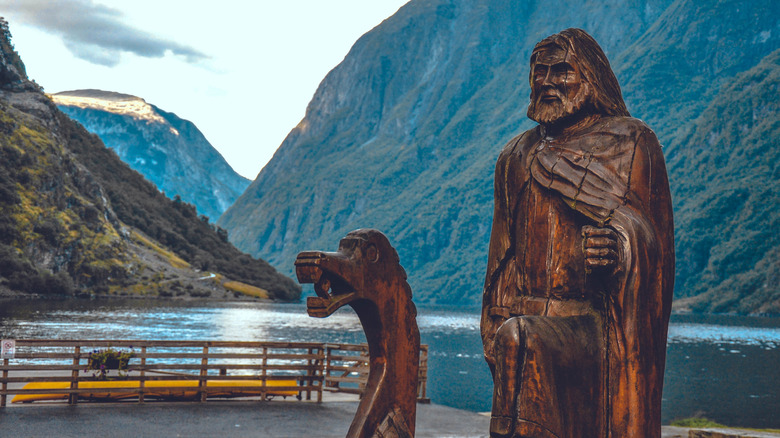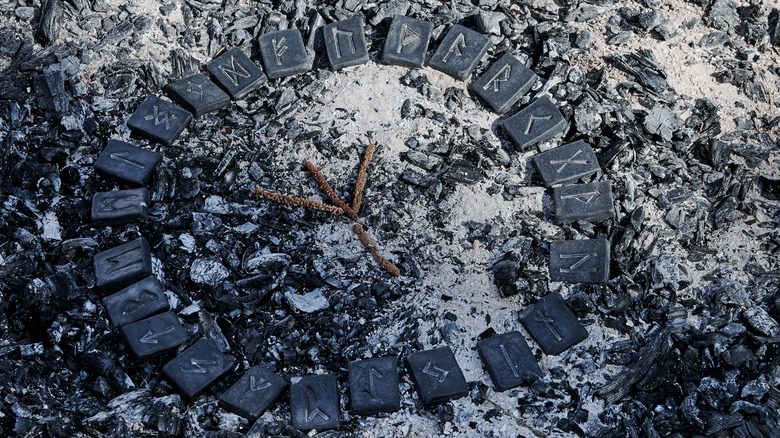The Origins Of Ancient Norse Mythology Explained
At this point, plenty of folks will likely recognize names like Odin, Thor, and Loki, and terms like Ragnarok, Yggdrasil, and Mjölnir from our global, shared culture. At the very least, the MCU's megabillion-dollar enterprise has reprised many of these gods, goddesses, artifacts, and events in the minds of the modern public. Thor, the hammer and lightning guy, and Loki, the magic trickster guy, come to mind immediately.
Such characters, tales, and myths comprise what is called Norse mythology, which originated in the Nordic countries of Scandinavia (modern-day Norway, Sweden, and Denmark), but particularly Norway. From there, they spread down into Europe (but especially Germany and France), up into Anglo-Saxon England, and out to Iceland and Greenland in the hearts of Vikings, those sea-faring, trading, and of course pillaging and raiding forbears of many a modern tattoo, man-bun undercut, and History channel shows like the eponymous "Vikings" (2013-2020).
Unlike highly-documented Greek mythology, Norse myths circulated for hundreds of years in unwritten oral tales. Various tribes across wide expanses of rugged, harsh land shared and told these stories in lots of different permutations. And today, as Vikingeskibs Museum says, we've got Tuesday (Tyr's Day), Wednesday (Woden's Day, another name for Odin), Thursday (Thor's Day), and Friday (Frigg's Day, another name for Freya). Norse myth has lived on, quietly or otherwise, and resonates with millions of people worldwide. But if not for a couple of key texts, particularly the Eddas, we wouldn't have these stories at all.
The Eddas and Icelandic Sagas
There's no central text, or canon, to Norse myths that encapsulates every story and immutably preserves them in an unchanging fashion. Even the Eddas are not comprehensive, and reveal what is likely only a sliver of a massive body of tales now lost to time. And what they describe, or mythologize, took place some unknown amount of time before they were finally written down in the 13th century.
As World History relates, the Eddas are split into two books: the "Poetic Edda" (also "Elder Edda") and the "Prose Edda" (also "Younger Edda"). The "Poetic Edda" employs the dominant form of storytelling and writing of Medieval Europe, poetry, and comes from material mostly found in a single Icelandic manuscript, the Codex Regius. The "Prose Edda" is a reorganized and rewritten prose version of Norse myths that pulls from a variety of sources. Both were put to print in Scandinavia's lingua franca, Old Norse, by the Icelandic poet and historian Snorri Sturluson in the mid-1200s. These stories, all in all, focus on the gods and their squabbles, schemes, and conflicts along a grand timeline of events that ends in the destruction of the world: Ragnarok.
Besides the Eddas, the Icelandic Sagas (over 40 novel- and short story-length tales) bring us not stories of gods, but down-to-Earth, straightforward narratives of everyday farmers and Vikings in Iceland. These people comprised the greater Norse society, and give us a glimpse into the kind of culture that the Eddas come from.
Hammers, dwarves, foldable ships, and a lost eye
As Historiska explains, Odin is one of the most prominent and complex characters in Norse myth. Along with his brothers Vili and Ve, he killed the primordial giant Ymir and fashioned the "middle Earth" — Midgard — from the body. Odin is generally a closed, not-at-all-fatherly figure who rides an eight-legged horse, Sleipnir. He sacrificed an eye to Mimir's Well to gain wisdom and visions of the future, and hung upside on Yggdrasil for nine days and nights to attain insight into the magic of runes. He also has two ravens, Hugin and Munin (thought and memory), who send him reports from around the world.
The Aesir and Vanir (families of gods) reside above in Asgard, one of the nine realms of existence built around the world tree, Yggdrasil. The world below is split into the fire realm, Muspelheim, the frost realm, Niflheim, and Hel, where the unhonored dead hang out for eternity. Besides humans, the realms are inhabited by dwarves who love to tinker, giants who are sometimes selfish and cruel, the serpent Jörmungandr that guards Midgard, and much more.
Some story highlights: Thor poses as a bride to retrieve his stolen hammer from the giant Thrym. Loki stages a crafting contest among the dwarves, which yields Tyr's foldable boat, Thor's hammer (Mjölnir), and the golden hair of Thor's wife, Sif. Tyr loses a hand to Loki's son, the giant wolf Fenrir, who will devour the sun at Ragnarok.
Snorri Sturluson wrote it all down
There are loads more Norse stories, many of them quite complex. Ultimately, Odin wants to cultivate the best warriors for the final battle of the gods and elves against the giants at Ragnarok. The souls of warriors who die in battle are harvested by Valkyries, women gifted to escort the slain to Valhalla. There, warriors literally fight day and night, dying and being re-born, in endless preparation for Ragnarok. Victory at Ragnarok, though, is a fruitless endeavor. Unlike other myths, Norse myths have a single, defined end where ambition yields death for almost everyone, and a world born anew.
The Eddas, Icelandic Sagas, and labors of historians and scholars over the centuries helped preserve such a unique tradition. Snorri Sturluson, the first to compile Norse myths, was in fact an Icelandic Christian who lived in the 13th century after the "Viking Age" (about 790-1100 CE). Even though he sometimes painted Norse gods through a Christian lens, he recognized the necessity of preserving the heritage of his country and region. As the Icelandic Literature Center says, he was an educated poet who wielded his literary skill to travel around Scandinavia and get in close with the Norwegian court, and was also elected twice to the position of Lawspeaker at the Icelandic Commonwealth's parliament, the Althing. All in all, he was in the perfect position to act as a waystation between eras and cultures. And so, Odin, Thor, Loki and more live on.



